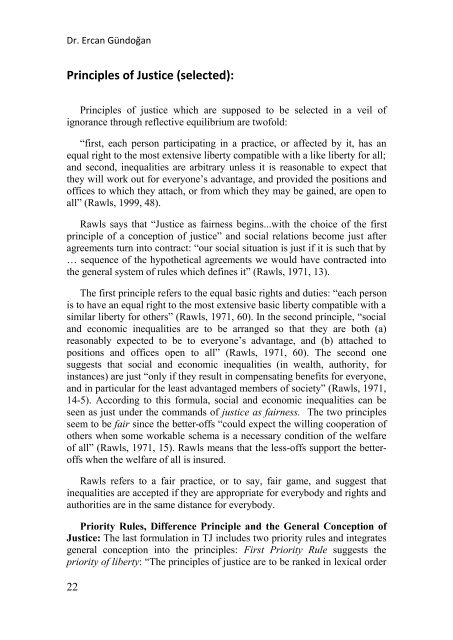SEEU Review vol. 5 Nr. 2 (pdf) - South East European University
SEEU Review vol. 5 Nr. 2 (pdf) - South East European University
SEEU Review vol. 5 Nr. 2 (pdf) - South East European University
Create successful ePaper yourself
Turn your PDF publications into a flip-book with our unique Google optimized e-Paper software.
Dr. Ercan Gündoğan<br />
Principles of Justice (selected):<br />
Principles of justice which are supposed to be selected in a veil of<br />
ignorance through reflective equilibrium are twofold:<br />
“first, each person participating in a practice, or affected by it, has an<br />
equal right to the most extensive liberty compatible with a like liberty for all;<br />
and second, inequalities are arbitrary unless it is reasonable to expect that<br />
they will work out for everyone’s advantage, and provided the positions and<br />
offices to which they attach, or from which they may be gained, are open to<br />
all” (Rawls, 1999, 48).<br />
Rawls says that “Justice as fairness begins...with the choice of the first<br />
principle of a conception of justice” and social relations become just after<br />
agreements turn into contract: “our social situation is just if it is such that by<br />
… sequence of the hypothetical agreements we would have contracted into<br />
the general system of rules which defines it” (Rawls, 1971, 13).<br />
The first principle refers to the equal basic rights and duties: “each person<br />
is to have an equal right to the most extensive basic liberty compatible with a<br />
similar liberty for others” (Rawls, 1971, 60). In the second principle, “social<br />
and economic inequalities are to be arranged so that they are both (a)<br />
reasonably expected to be to everyone’s advantage, and (b) attached to<br />
positions and offices open to all” (Rawls, 1971, 60). The second one<br />
suggests that social and economic inequalities (in wealth, authority, for<br />
instances) are just “only if they result in compensating benefits for everyone,<br />
and in particular for the least advantaged members of society” (Rawls, 1971,<br />
14-5). According to this formula, social and economic inequalities can be<br />
seen as just under the commands of justice as fairness. The two principles<br />
seem to be fair since the better-offs “could expect the willing cooperation of<br />
others when some workable schema is a necessary condition of the welfare<br />
of all” (Rawls, 1971, 15). Rawls means that the less-offs support the betteroffs<br />
when the welfare of all is insured.<br />
Rawls refers to a fair practice, or to say, fair game, and suggest that<br />
inequalities are accepted if they are appropriate for everybody and rights and<br />
authorities are in the same distance for everybody.<br />
Priority Rules, Difference Principle and the General Conception of<br />
Justice: The last formulation in TJ includes two priority rules and integrates<br />
general conception into the principles: First Priority Rule suggests the<br />
priority of liberty: “The principles of justice are to be ranked in lexical order<br />
22

















